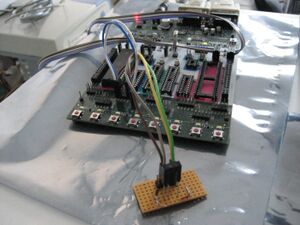Avr rc5 remote control
From Electriki
Jump to navigationJump to search
Introduction
Interfacing a standard Philips RC5 protocol remote control to an AVR is easy. It doesn't have take neither much hardware nor code to do so. I've found that there is an official application note from Atmel describing how to do this. Atmels example is done in assembler and is fault tolerant, but it's difficult to understand. By doing it in C it becomes very simple and understandable.
The Code
The stripped down C code:
#include <avr/interrupt.h>
#include <avr/io.h>
#include <util/delay.h>
typedef union {
uint16_t raw;
struct {
unsigned cmd : 6; // LSB
unsigned addr : 5;
unsigned toggle : 1;
unsigned start : 2;
unsigned : 2; // MSB
};
} rc5data;
static volatile int flag = 0;
static volatile rc5data data;
void init_int0()
{
// Interrupt on INT0 pin going low
MCUCR = (1 << ISC01);
// Turn on INT0!
GICR |= (1 << INT0);
}
SIGNAL (INT0_vect)
{
int pos = 0;
if (!flag) {
data.raw = 0;
// triggers on faling edge of start bit 1.
_delay_ms(0.2);
while (pos < 14) {
data.raw = (data.raw << 1) | ((~PIND & 0x04) >> 2);
_delay_ms(1.8);
pos++;
}
flag = 1;
}
}
int main()
{
init_int0();
sei(); // Enable interrupts
while(1) {
while(!flag);
// Do with data from the remote control here what you like.
flag = 0;
}
return 0;
}
